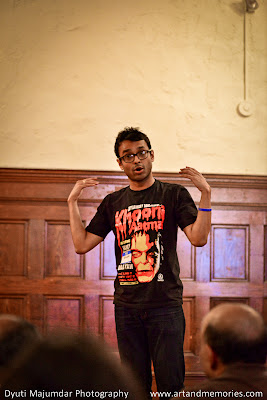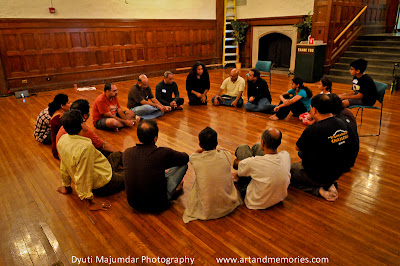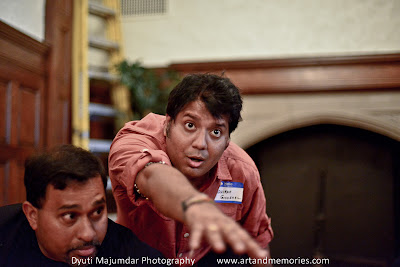Tickets for the latest show of VOICES can be bought at:
https://off-kendrik.yapsody.com/event/index/34730/voices-stories-of-southasian-immigrants
OFF-KENDRIK
Monday, May 30, 2016
Thursday, May 19, 2016
VOICES
“Voices “ is a collective journey presented through the lens of South Asian immigrants and their children. A rich mosaic of South Asian immigrant experiences in the Greater Boston area is presented through intimate storytelling: stories of cultural snafus, verbal gaffes, experiences that are historic in nature, teenage games and unexpected phone calls. Eight presenters speak about sometimes intimate, often life-changing events or issues that they have grappled with or continue to endure in this country. These are people from the community, with no formal theater experience, who want to share their stories. The group includes people who have lived here for over fifty years as well as young adults that have grown up in the Boston suburbs. Presented through a multilingual format (Bangla and English), this tapestry covers fifty years of multigenerational experience.
Off-Kendrik has been an independent theater group in the Greater Boston community for almost a decade. It has worked on ‘original’ plays in Bangla. Using a minimalistic approach, the group’s work has been experimental, with particular attention to the contours of the complex immigrant experience in the current millennium. “Voices” is a progression for the group;it allows people in the community to share their unique experiences and connectivity. It is our hope that ‘Voices’ will be presented biannually, in Spring and Fall, allowing us to share and grow together as a diverse community.
Presenters:
Tapati Lahiri (Sat): “Letters from my mother”
Manisha Ray (Sunday): “Burned into memory”
Souvik Chattopadhyay: “Wheat or white”
Nilay Mukherjee: “3-am phone call”
Shuvom Sadhuka: “A discourse on education: Western vs Eastern”
Chandreyee Lahiri: “Odometer clicks”
Abdulla Shibli: "What I want to tell Shaki, Naushi and Mira"
Saptak Ray: “In search of home”
Mahua Mukhopadhyay: “Dark road, white house”
Another goal of Off-Kendrik is to use some of the proceeds from “Voices” to support theater artists in medical need back in India. I hope you can support the cause, while enjoying the rich tradition of story-telling.
Details about the show:
Tickets are $15; $10 for chidren 12 and under and students with ID.
Location: Davis Square Theater, 255 Elm Street, Somerville
Tickets can be bought at https://off-kendrik.yapsody.com/
Details about the show:
Tickets are $15; $10 for chidren 12 and under and students with ID.
Location: Davis Square Theater, 255 Elm Street, Somerville
Tickets can be bought at https://off-kendrik.yapsody.com/
Friday, July 3, 2015
Boro Holo J (J comes of age) - Upcoming show
OFF-KENDRIK PRESENTS
BORO HOLO J (J Comes of age)
A BANGLA PLAY (with English supertitles) BY SANKHA BHOWMICK
Tickets: General - $15; Graduate Students- $12; Kids (12 and below)- $10
SYNOPSIS
Boro Holo Ja, an award winning play being staged by Off-Kendrik, has its roots in Sukumar Ray’s (Satyajit
Ray's dad) Bengali classic “Ha Ja Ba Ra La”, which in turn was inspired by Lewis Carrol’s “Alice in
Wonderland”. In Ray’s original tale a young, unnamed child, similar to Alice, falls asleep under a shady
tree and wakes up to a world occupied by talking animals, unidentifiable creatures and strange humans.
Boro Holo Ja is a Bengali anagram of Ha Ja Ba Ra La, but unlike the nonsensical title of the original, the
anagram spells out “Ja Comes of Age”. The young child of Ha Ja Ba Ra La, now named Ja, is currently in
New York. He appears to be a daily jobber in today’s rat race, a slave to the capitalist machine, but is he
truly? This play follows Ja in his plight through a world inhabited by demanding bosses, slick
consultants, lawyers seeking frivolous lawsuits, media savvy entrepreneurs, and fast talking hedge fund
managers. Through a series of episodes, the play presents a satirical look at today’s capitalistic society.
The style of the play falls within the theater of the absurd, and is reminiscent of works by Stoppard,
Beckett, Ionesco, Pinter and others.
Off-Kendrik is an 'independent' Bangla theater group in the greater Boston area. Several members of
the group trace their theater inspiration to the' group theater' movement in Kolkata. The group
produces plays based on 'original' writing by group members or adaptation from Bangla literature
including poetry. Our work can be found at www.offkendrik.blogspot.com. Some samples are present
on our Facebook page www.facebook.com/Off-Kendrik.
Tickets can be purchased
online at http://www.eventedge.biz/event/Boro-Holo-J-J-comes-of-age/189.html OR
Call: Sankha @8572054985; Souvik@7163100403
Thursday, April 23, 2015
Thursday, February 21, 2013
Theater workshop 2012
Off-Kendrik held a two-day theater workshop on Saturday, 15 September and Sunday, 16 September, 2012 at the Riley Commons of Worcester Polytechnic Institute, Massachusetts. The regular members were joined by a few interested non-members, and the workshop was conducted by Dipankar Mukherjee, Artistic Director of Pangea World Theater of Minneapolis. There were sixteen participants of various ages and both genders, with a ten-year-old girl as the youngest of the team. A recent script titled “Ba Ra Ha La Ja”, built on the legendary “Ha Ja Ba Ra La” by Sukumar Ray and written by Sankha Bhowmick, was the primary impetus behind the workshop.
Following self-introductions, a team warm-up was led, under the direction of Mukherjee, by the two youngest participants. The team then became engaged in a variety of tasks. The following are a few of the assignments.
Different kinds of gait involving the different areas of the torso, the point of which was to notice the very different expressions they generate: head walking (thoughtfulness), chest walking (pomposity), and waist walking (shyness or instability). Then each participant employed all three styles, switching at random. Finally, each person emulated the walking style of someone else in the team.
 Next, the participants were lined in two rows, and then steadily marched to the end of the workshop arena and back, without looking at the rest of the line to adjust space or pace. The turn-around for the return trip was particularly tricky, as no one knew for sure which way (right or left) the others were going to rotate to face the opposite direction. The purpose of this exercise was to develop group coordination through perceptive vision.
Next, the participants were lined in two rows, and then steadily marched to the end of the workshop arena and back, without looking at the rest of the line to adjust space or pace. The turn-around for the return trip was particularly tricky, as no one knew for sure which way (right or left) the others were going to rotate to face the opposite direction. The purpose of this exercise was to develop group coordination through perceptive vision.
For the next task, the whole team arranged itself in an equilateral triangle, with someone at the apex acting as the leader. The team would then blindly follow the leader’s gestures (for example, the leader could wave both hands in the air, or pat her/his head while walking, which the others would have to mimic) as the entire triangle advanced to the other end of the arena, all the while maintaining the triangular formation. Once there, the triangle swiftly inverted itself, with someone previously at the base assuming the leadership position at the apex. The team then advanced toward the opposite end, following the physical cues from the new leader.
“Sculpture building” took three forms. First, the participants were divided into groups of four, each of which made a static group formation based on a concept that created a theatrical moment. Next, the four members of each built another structure by touching one another, yet remaining on different levels from the ground. Finally, each group moved through the arena, while its members maintained bodily contact with one another.
Character acting took several forms as well. First, each participant, having chosen a picture of a fashion model from a sales catalog, imagined and enacted the movements and mannerisms of the person in the picture in social spaces. Since the pictures were distributed randomly, some of the male participants ended up with images of women, and vice versa. The objective here was to invent characters via pictorial clues. Next, all the characters inhabited a shopping mall, where one of them suddenly passed out and dropped to the ground. All the other characters in the crowd then had to address that incident according to the invented character traits. Finally, the characters interacted with one another as guests at a Bengali wedding reception.

In a different mode of character acting, each participant read a poem written by the youngest member of the group, and acted out a short sequence based on the content of the poem.
The workshop was a novel and immensely beneficial experience for the entire team, but especially for those who had never attended a theater workshop.
Following self-introductions, a team warm-up was led, under the direction of Mukherjee, by the two youngest participants. The team then became engaged in a variety of tasks. The following are a few of the assignments.
Different kinds of gait involving the different areas of the torso, the point of which was to notice the very different expressions they generate: head walking (thoughtfulness), chest walking (pomposity), and waist walking (shyness or instability). Then each participant employed all three styles, switching at random. Finally, each person emulated the walking style of someone else in the team.
 Next, the participants were lined in two rows, and then steadily marched to the end of the workshop arena and back, without looking at the rest of the line to adjust space or pace. The turn-around for the return trip was particularly tricky, as no one knew for sure which way (right or left) the others were going to rotate to face the opposite direction. The purpose of this exercise was to develop group coordination through perceptive vision.
Next, the participants were lined in two rows, and then steadily marched to the end of the workshop arena and back, without looking at the rest of the line to adjust space or pace. The turn-around for the return trip was particularly tricky, as no one knew for sure which way (right or left) the others were going to rotate to face the opposite direction. The purpose of this exercise was to develop group coordination through perceptive vision.For the next task, the whole team arranged itself in an equilateral triangle, with someone at the apex acting as the leader. The team would then blindly follow the leader’s gestures (for example, the leader could wave both hands in the air, or pat her/his head while walking, which the others would have to mimic) as the entire triangle advanced to the other end of the arena, all the while maintaining the triangular formation. Once there, the triangle swiftly inverted itself, with someone previously at the base assuming the leadership position at the apex. The team then advanced toward the opposite end, following the physical cues from the new leader.
For another assignment, each participant walked casually, until the ring of a bell prompted the individual to react to an imagined scene of a vehicle about to run over a child who has just run into the street, chasing a ball. The goal was to generate instantaneous expressions of horror and despair.
Character acting took several forms as well. First, each participant, having chosen a picture of a fashion model from a sales catalog, imagined and enacted the movements and mannerisms of the person in the picture in social spaces. Since the pictures were distributed randomly, some of the male participants ended up with images of women, and vice versa. The objective here was to invent characters via pictorial clues. Next, all the characters inhabited a shopping mall, where one of them suddenly passed out and dropped to the ground. All the other characters in the crowd then had to address that incident according to the invented character traits. Finally, the characters interacted with one another as guests at a Bengali wedding reception.

In a different mode of character acting, each participant read a poem written by the youngest member of the group, and acted out a short sequence based on the content of the poem.
The workshop was a novel and immensely beneficial experience for the entire team, but especially for those who had never attended a theater workshop.
Sunday, December 18, 2011
Retreat 2011
After its first retreat in November 2009, Off-Kendrik had its second retreat from November 18 to 21, 2011 at the same rented house in Cape Cod. The group’s primary objective this year was to explore possibilities of a future production stemming from Sukumar Ray’s “Ha Ja Ba Ra La”.
The workshop took three forms, albeit with a common goal: characterization. In the first phase, each of seven individuals drew on one character from “Ha Ja Ba Ra La” to improvise in the face of an aggressive interrogation. An “outsider” (i.e. someone not playing any character from the play) intimidated them by asking random, intrusive questions, and each person had to respond immediately with the mannerisms of the specific character from the play that s/he represented. The second exercise, in contrast, was a monolog prepared over a short time. As previously, the delivery was meant to exploit the idiosyncrasies of specific “Ha Ja Ba Ra La” characters, while the contents were the performers’ own. What is more, each performer interacted with an object of personal choice during the monolog, but in a manner incongruent to the basic identity of the object; for instance, while a book was used as a phone in one monolog, a cushion served as a book in another. Also planned over a short time, the third workout was conversational. Each group of two or three players engaged in an absurd exchange for a few minutes, building the conversation around the essential traits of Ray’s characters being portrayed. All of these performances were meticulously photographed and videotaped.
In addition to the above exercises, scenes from Utpal Dutta’s “Ajker Shajahan” and D.L. Roy’s “Shajahan” were read. Finally, Dyuti Mazumdar, the group’s photographer, photographed some of the members in a variety of expressive moments.
In light of these activities, it was decided that more concerted efforts would be made to produce a script with fodder from “Ha Ja Ba Ra La”, and that the reading from scripts of well-known plays would be made into a regular practice at the group’s monthly meetings.
The workshop took three forms, albeit with a common goal: characterization. In the first phase, each of seven individuals drew on one character from “Ha Ja Ba Ra La” to improvise in the face of an aggressive interrogation. An “outsider” (i.e. someone not playing any character from the play) intimidated them by asking random, intrusive questions, and each person had to respond immediately with the mannerisms of the specific character from the play that s/he represented. The second exercise, in contrast, was a monolog prepared over a short time. As previously, the delivery was meant to exploit the idiosyncrasies of specific “Ha Ja Ba Ra La” characters, while the contents were the performers’ own. What is more, each performer interacted with an object of personal choice during the monolog, but in a manner incongruent to the basic identity of the object; for instance, while a book was used as a phone in one monolog, a cushion served as a book in another. Also planned over a short time, the third workout was conversational. Each group of two or three players engaged in an absurd exchange for a few minutes, building the conversation around the essential traits of Ray’s characters being portrayed. All of these performances were meticulously photographed and videotaped.
In addition to the above exercises, scenes from Utpal Dutta’s “Ajker Shajahan” and D.L. Roy’s “Shajahan” were read. Finally, Dyuti Mazumdar, the group’s photographer, photographed some of the members in a variety of expressive moments.
In light of these activities, it was decided that more concerted efforts would be made to produce a script with fodder from “Ha Ja Ba Ra La”, and that the reading from scripts of well-known plays would be made into a regular practice at the group’s monthly meetings.
Saturday, July 30, 2011
Subscribe to:
Posts (Atom)






